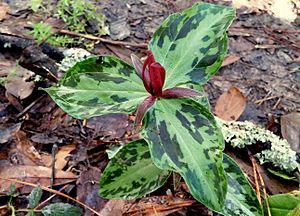Mississippi River wakerobin facts for kids
Quick facts for kids Mississippi River wakerobin |
|
|---|---|
 |
|
| Trillium foetidissimum in bloom in Baton Rouge, LA, USA | |
| Conservation status | |
| Scientific classification | |
| Genus: |
Trillium
|
| Species: |
foetidissimum
|
| Synonyms | |
|
|
The Trillium foetidissimum, also called the Mississippi River wakerobin, is a cool flowering plant! People also sometimes call it the stinking trillium or fetid trillium because of its unique smell. This plant belongs to the plant family called Melanthiaceae. You can find it growing naturally along the border between Louisiana and Mississippi in the USA. It likes to live in different kinds of places there.
This plant is a perennial herbaceous plant, which means it's a soft-stemmed plant that lives for more than two years. It blooms, or flowers, in early spring, usually from early March to early April.
What Does It Look Like?
The Mississippi River wakerobin has brown parts underground called rhizomes. These are like horizontal stems that help the plant spread. It also has special leaf-like structures called bracts.
Stems and Leaves
Each plant usually has one or two stems, called scapes. These stems can be green or maroon and are round. They grow to be about 8 to 28 centimeters (about 3 to 11 inches) tall. The leaves of this plant can be either a light green or a bronze-green color. They often have cool patterns or spots, which is called "mottled."
Flowers and Petals
The flowers of the Trillium foetidissimum are very interesting!
- Sepals: These are green, leaf-like parts found just below the petals. They are shaped like a spearhead and are quite thick. They can be about 1.6 to 4 centimeters (about 0.6 to 1.6 inches) long and 0.4 to 0.6 centimeters (about 0.16 to 0.24 inches) wide.
- Petals: The petals stand upright and are narrow, like a spearhead. They are usually a maroon color that fades to brown.
- Stamens: Inside the flower, you'll find the stamens, which are the parts that produce pollen. They are dark maroon and stand upright. The anthers, which hold the pollen, are blackish-maroon and straight.
- Ovary and Stigma: The plant's ovary, where seeds will form, is reddish-purple and shaped like an egg. The stigma, which receives pollen, is also dark purple and stands upright.
The Unique Smell
One of the most interesting things about the Mississippi River wakerobin is its smell! The flower gives off a scent that smells like rotting meat. This might sound gross to us, but it's a clever trick to attract insects. These insects, like flies, help pollinate the flower, meaning they carry pollen from one flower to another, helping the plant make seeds. This is why it's sometimes called the "stinking trillium"!
Fruit
After the flower blooms, it turns into a purple-brown berry in the autumn. This berry holds the plant's seeds.


